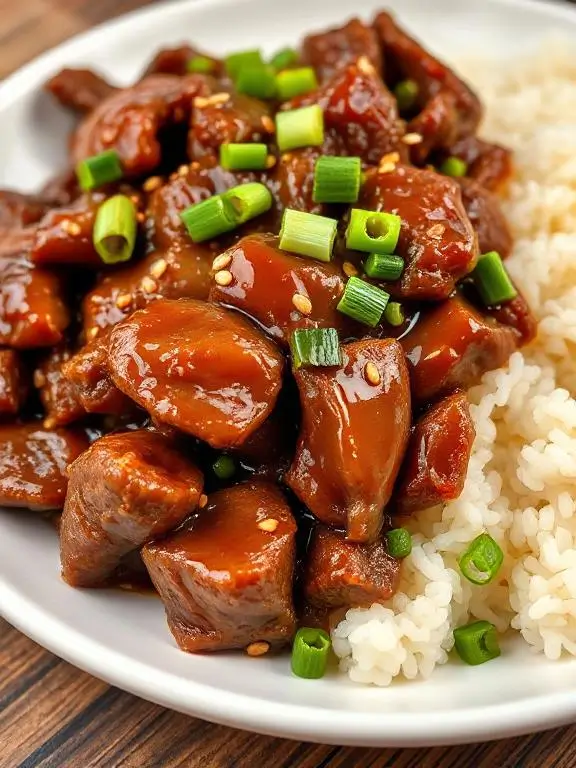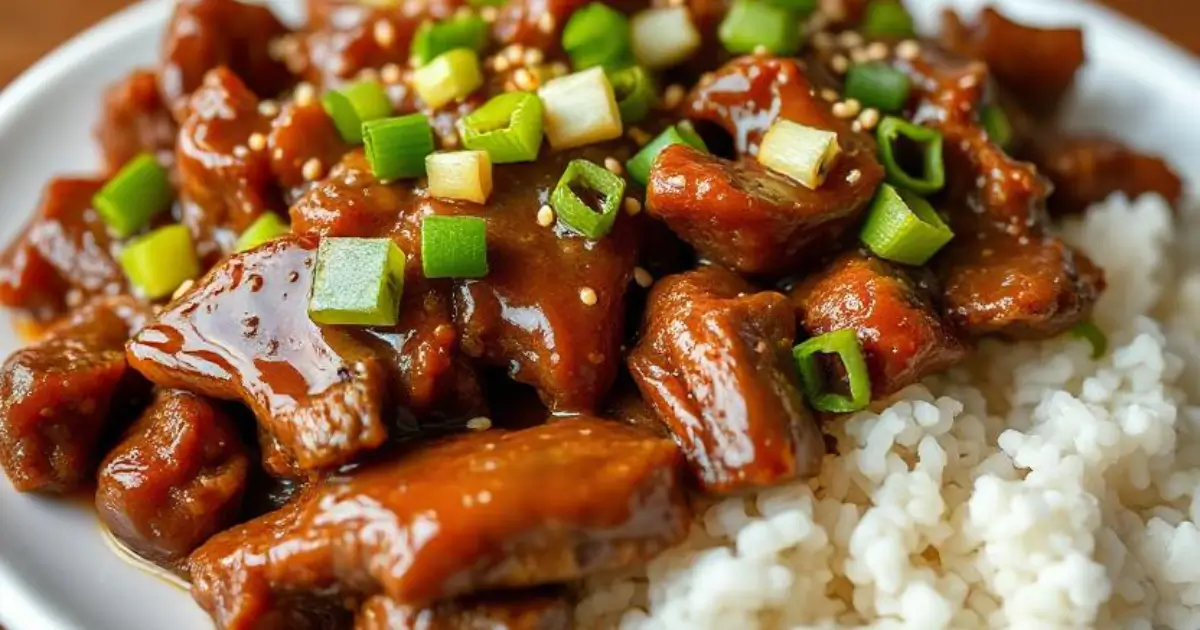Mongolian Beef is a delicious dish made with tender beef in a savory and slightly sweet soy-based sauce. The flavors of ginger, garlic, and brown sugar come together perfectly, making it a comforting and satisfying meal. Whether for a quick weeknight dinner or a special occasion, this recipe is sure to impress with its easy preparation and bold taste.
Why We Love This Mongolian Beef
Mongolian Beef is a crowd-pleasing dish that’s both simple to make and full of flavor. Here’s why we love it:
- Bold, Savory Flavor: The combination of soy sauce, ginger, garlic, and brown sugar creates a rich and perfectly balanced sauce. It’s savory, slightly sweet, and full of depth, making every bite irresistible.
- Quick and Easy: You don’t need to be a master chef to pull this off. With just a few ingredients and simple steps, you can whip up a meal that tastes like it’s from your favorite restaurant.

- Versatile: Whether you serve it over steamed rice or noodles or on its own, Mongolian Beef is incredibly flexible. You can even adjust the sauce to suit your taste by adding more or less sugar or soy sauce.
- Tender, Crispy Beef: The beef is cooked just right – crispy on the outside and tender on the inside. That contrast in texture makes this dish even more enjoyable.
- Perfect for Any Occasion: From a weeknight dinner to a weekend treat, Mongolian Beef fits any occasion. It’s quick enough for busy evenings but delicious enough to impress guests.
This recipe brings together the best of comfort food and Asian-inspired cuisine, offering a meal that’s satisfying, flavorful, and simple to make.
Ingredients for mongolian beef
- 1 lb flank steak (thinly sliced against the grain)
- 2 tablespoons vegetable oil
- 1/2 cup soy sauce
- 1/4 cup brown sugar
- 1 tablespoon ginger (freshly grated)
- 3 cloves garlic (minced)
- 1/2 cup water
- 2 tablespoons cornstarch
- 1/2 cup green onions (chopped)
Instructions
Making Mongolian Beef is quick and simple, and the result is a mouthwatering dish that will have everyone coming back for more. Follow these easy steps for a perfect meal:
Prepare the Beef:
Start by slicing your flank steak thinly against the grain. This ensures the beef stays tender after cooking. If needed, place the beef in the freezer for 20-30 minutes before slicing to make it easier to cut.
Cook the Beef:
Add 1 tablespoon of vegetable oil to a large pan or wok and heat it over medium-high heat. Add the beef in batches to avoid overcrowding, cooking until it’s golden and crispy. Each batch should take around 2-3 minutes to cook. Once done, remove the beef and set it aside.
Make the Sauce:
Pour the remaining 1 tablespoon of vegetable oil into the same pan. Sauté the minced garlic and grated ginger for 1-2 minutes, just until fragrant. Be careful not to burn them! Add the soy sauce, brown sugar, and water, stirring to combine.
Thicken the Sauce:
Combine 2 tablespoons of cornstarch with a small amount of water to form a slurry. Add this mixture to the sauce, stirring constantly. Let it simmer for 3-4 minutes until the sauce thickens to a glossy consistency.
Combine and Coat:
Add the cooked beef back into the pan, tossing it in the sauce to coat it evenly. Let it cook for another 1-2 minutes to absorb the sauce.
Garnish and Serve:
Finish by sprinkling chopped green onions over the top. Serve your Mongolian Beef hot with steamed rice or your favorite noodles.
This step-by-step process ensures you get that perfect tender, crispy beef with a rich, savory-sweet sauce that everyone will love.
Pro Tips
To make your Mongolian Beef even more delicious, here are some tips to ensure the best results:
Slice the Beef Thinly:
The key to tender Mongolian Beef is slicing the flank steak against the grain. Thin slices ensure that each piece is tender and absorbs the sauce beautifully. If you have trouble slicing thinly, pop the beef in the freezer for 20-30 minutes to firm it up and make cutting easier.
Avoid Overcrowding the Pan:
When cooking the beef, cook it in batches. Overcrowding the pan will prevent the beef from crisping up properly. If you add too much at once, it will steam rather than sear.
Balance the Sauce:
If you prefer a sweeter flavor, feel free to adjust the amount of brown sugar in the sauce. You can also add a splash of soy sauce for more saltiness or a pinch of chili flakes if you like a little heat in the dish.
Use Cornstarch for a Silky Sauce:
The cornstarch slurry is what gives the sauce its glossy, velvety texture. Be sure to stir constantly while adding the slurry to avoid any lumps, and let the sauce simmer for a couple of minutes for the perfect consistency.
Try Different Cuts of Beef:
While flank steak is traditional, you can experiment with other cuts like sirloin or ribeye for a different texture. Just make sure to slice it thinly and cook it quickly to keep the beef tender.
Make It Ahead:
Mongolian Beef can be made ahead and stored in the fridge for 2-3 days. The flavors actually improve overnight, making it a great dish for meal prep or leftovers!
Variations
Mongolian Beef is a versatile dish, and you can easily make it your own by adding a few variations.
Vegetarian Mongolian “Beef”:
If you’re looking for a vegetarian version, try swapping the beef with tofu or tempeh. Press the tofu to remove excess moisture, then cut it into cubes and fry until crispy. The sauce will coat the tofu just like it does the beef, giving you that same rich, savory flavor.
Add Veggies:
For a more balanced meal, toss in some vegetables like broccoli, bell peppers, or snow peas. Simply sauté them with the garlic and ginger before adding the beef and sauce. This adds color, texture, and an extra boost of nutrients.
Spicy Mongolian Beef:
If you love heat, kick up the spice level by adding chili flakes, sriracha, or even fresh sliced chilies to the sauce. This will add a pleasant heat to the dish without overshadowing the other flavors.
Lemon Mongolian Beef:
For a citrus twist, squeeze some fresh lemon juice into the sauce or garnish the dish with lemon zest. This adds a bright, refreshing element that complements the rich sauce.
Sweet and Sour Mongolian Beef:
Add a touch of rice vinegar or apple cider vinegar to balance the sweetness of the brown sugar. This will create a delightful sweet and sour flavor profile that’s just as satisfying.
Serving Suggestions
Mongolian Beef is a flavorful and hearty dish that pairs well with a variety of sides. Here are some ideas to create a balanced and satisfying meal:
Serve with Steamed Rice.
The rich and savory sauce of the Mongolian Beef is perfect when soaked up by a bowl of steamed white rice. The simple, neutral flavor of the rice balances out the dish and helps absorb all the delicious sauce.
Pair with Noodles:
For a twist, serve your Mongolian Beef over lo mein or rice noodles. The noodles will add a nice chewiness and soak up the sauce, making each bite even more satisfying.
Add a Fresh Salad:
A light Asian-style salad with cabbage, carrots, and a tangy dressing can be a refreshing contrast to the richness of the beef. The crunchiness of the veggies adds a nice texture to the meal.
More Beef recipes you will love!
FAQs
Here are some answers to the most frequently asked questions about Mongolian Beef to help you get the best results:
What is Mongolian beef supposed to taste like?
Mongolian Beef has a perfect balance of sweet and savory flavors. The sauce is rich and slightly sweet from the brown sugar and soy sauce, with a touch of ginger and garlic that give it depth. The beef is tender and coated in a glossy, flavorful sauce that makes each bite irresistible.
What is the difference between Szechuan and Mongolian beef?
The key difference lies in the flavor profile and ingredients. Mongolian beef is typically sweeter and more savory with a mild heat, while Szechuan beef is spicier and often features Szechuan peppercorns, giving it a unique numbing sensation. Szechuan beef also tends to have more of a vinegary and tangy flavor compared to the sweeter, rich sauce of Mongolian beef.
What is Mongolian flavor?
Mongolian flavor is often described as sweet, savory, and slightly spicy. It’s created by combining soy sauce, brown sugar, garlic, ginger, and a touch of chili flakes or hoisin sauce. The sauce is thickened with cornstarch, creating a silky, glossy finish. This flavor profile is designed to enhance the natural umami of the beef, making it both satisfying and flavorful.



